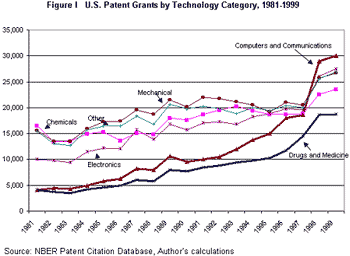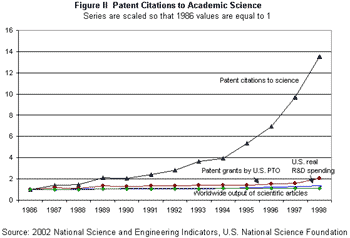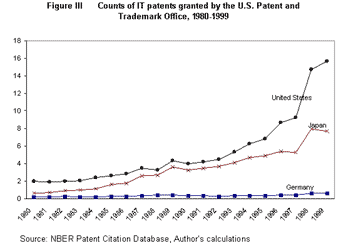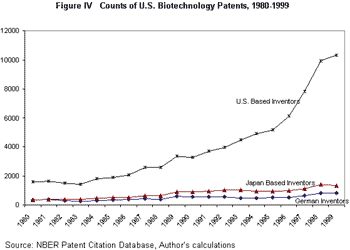Recent research points to an evident surge in innovative activity in the United States over the past fifteen years.1 This is suggested by, among other things, a sharp rise in patent applications and patent grants that started in the late 1980s and has persisted through the end of the 1990s - a rise that has outpaced, by a considerable margin, increases in public and private R&D spending. Figure I illustrates growth in U.S. patenting across a range of technological fields. While a large fraction of U.S. patent grants are awarded to foreign inventors, the fraction obtained by domestic inventors has risen - and this fraction has risen particularly rapidly in fields where patenting has grown most sharply. The recent patent surge could potentially be explained by an increase in the propensity of Americans to patent inventions, rather than an increase in the productivity of American research and development, but the recent research of Kortum and Lerner [1998, 2000, 2003] strongly suggests that recent trends in patenting and related data are more consistent with the latter interpretation. If this conclusion is correct, then it could help explain the widely observed increase in U.S. total factor productivity (TFP) growth in recent years.2
But if American R&D productivity has increased, then that raises the question of what factors are driving the increase.3 One of my recent papers attempts to assess the importance of one possible contributing factor - increased knowledge spillovers from U.S.-based academic science.4 In essence, this paper is an attempt to explain the phenomenon graphed out in Figure II. This figure shows that citations made by patents granted in the United States to articles in the scientific literature increased very rapidly from the mid 1980s through the late 1990s.5 Under U.S. patent law, all patent applicants are required to make "appropriate citations to the prior art." That is, inventors are required to identify the prior inventions and discoveries on which they build. Traditionally, inventors seeking U.S. patent protection for their inventions have cited prior patents. Increasingly, however, inventors based in the United States are citing scientific papers documenting advances made by university-based academic scientists. Given the structure of U.S. patent law, there are explicit penalties for omitting citations to important prior inventions or discoveries and there are also costs to including superfluous citations. Recent research by American economists, such as Jaffe, Fogarty, and Banks [1998], demonstrates that a significant fraction of patent citations reflect knowledge spillovers.
From the mid-1980s through the late 1990s, the number of patents granted by the U.S. Patent and Trademark Office to U.S. residents more than doubled, real R&D expenditures in the United States rose by almost 40%, and global output of scientific articles increased by about 13%, but patent citations to scientific articles increased more than 13 times.6 Many at the National Science Foundation and other U.S. science policy agencies find this graph extremely interesting, because it seems to suggest - at least in some broad sense - that academic science and industrial technology are "closer" than they used to be. This could mean that publicly funded science is generating more spillovers to industrial innovation than in the past.7 This, in turn, may have contributed in important ways to the apparent surge of innovative activity in the United States in the 1990s.
This positive interpretation of recent trends in the data is influenced by the theoretical contributions of Evenson and Kislev [1976] and the more recent analysis their work inspired, such as Adams [1990] and Kortum [1997]. In this general class of models, applied research is a search process that eventually exhausts the technological opportunities within a particular field. However, basic science can open up new "search distributions" for applied researchers, raising the productivity and the level of applied research effort - at least temporarily. Viewed through this theoretical lens, the concurrence of rapid growth in U.S. private R&D expenditures, even more rapid growth in patenting, mounting evidence of an acceleration in TFP growth, and still more rapid growth in the intensity with which U.S. patents cite academic science would all seem to suggest a response to new technological opportunities created by academic research. Not surprisingly, other advanced industrial nations are deliberately trying to foster closer connections between university-based scientific research and industrial R&D in conscious imitation of the "U.S. model."
However, increasingly strong knowledge spillovers from academic science to industrial R&D are only one of several factors that could be driving the changes illustrated in Figure II. Furthermore, even if such knowledge spillovers are growing in strength, this could be happening in a number of different ways, which have different implications for public policy. A little thought and a cursory reading of the recent literature generate at least four alternative hypotheses that could explain the recent trends in the data. The first is the "increasing scientific fertility" hypothesis, which posits that more recent cohorts of scientific papers contain more discoveries that are directly applicable to industrial research and development, and that this trend holds across many fields of science. Under this hypothesis, knowledge spillovers from academia to industry are increasing primarily because of a qualitative change in the nature of the science being conducted at universities.8
The second is the "changing methods of invention" hypothesis, which posits that industrial inventors have changed the way they create new technology. The new approach to R&D draws more heavily on academic science than in the past, though it does not necessarily draw exclusively on the most recently published articles. This would be reflected in an increasing propensity for more recent cohorts of patents across a wide range of technical fields to cite science. Now, this increased propensity for more recent patents to cite science could very well reflect a response by firms to new "technological opportunities" generated by academic scientific breakthroughs. The point being stressed is that it is the inventors themselves who are generating the increased citations as they alter the direction and nature of their R&D programs to probe the new opportunities for industrial research created by basic science. Like the first hypothesis, this implies that knowledge spillovers from academic science are increasing over time, but the mechanism driving this increase is different.
The third is the "changing composition of invention" hypothesis, which posits that invention in certain areas of technology has been closely linked to science for some time, and, likewise, some fields of science have always been frequently cited by industrial patents. Under this hypothesis, there has been disproportionate growth in patenting in frequently citing patent classes. Similarly, growth in academic publications has been biased towards those fields of science which have historically been more closely linked to industrial R&D. In other words, at the level of individual technology classes and scientific fields, there has been little change in the relationship between science and technology per se - rather there has been a change in the distribution of patents and papers that generates the observed increase in citations. A variant of this hypothesis notes that there has been rapid growth in patenting by universities, and that this change in the composition of inventors might also contribute to the growth in patent citations to science.
Strongly biased growth in frequently citing patent classes and frequently cited fields of science could itself reflect a response by both industrial inventors and academic scientists to the "technological opportunities" created by a series of fundamental scientific breakthroughs. In fact, one might find within this "nexus" of patent classes and scientific fields evidence of changing methods of invention and/or increases in scientific fertility, such that the intensity of interaction between science and invention actually grows over time. The point being stressed in this "changing composition" hypothesis is that the new technological opportunities, if they exist, are quite specific to a small number of technical and scientific fields, and one does not observe a broad-based change across fields of technology or fields of science that is consistent with substantially changing methods of invention or substantially increased scientific fertility.
The fourth hypothesis is the "attorney-driven" hypothesis, which posits that the change in patent citations is entirely driven by changes in citations practices. For various strategic reasons connected to the desire to impress patent examiners, the fear of subsequent litigation, or both, patent lawyers have instructed their clients to increase the number of citations made to the scientific literature. The increasing availability of data on the scientific prior art in electronic form has lowered the costs of such citations, further contributing to their growth. This hypothesis, in its extreme version, suggests that little can be learned about the changing relationship between science and technology from patent citation data.
These hypotheses are not mutually exclusive, but they have quite different implications for the appropriate interpretation of the growth in patent citations to papers. In order to understand what Figure II really means, how it relates (or not) to the recent American innovation surge, and what the appropriate policy response is, it is necessary to sort out the relative importance of these hypotheses in explaining the trend illustrated in that graph.
My recent paper, Branstetter [2003] [PDF:720KB], is largely devoted to an examination of the relative importance of these hypotheses within a common empirical framework. I find that aggregate trends in the data are largely explained by a combination of the "composition hypothesis" and the "changing methods of invention" hypothesis. To a surprising extent, the measured increase in patent citations to papers is localized within a relatively narrow set of technologies and scientific fields related to biotechnology that I will term the "bio nexus." Patenting and publication in these fields has grown over time, and inventors working in these technologies have substantially increased the extent to which they build on science. Citations to science have also increased outside the bio nexus, and the relative change over time has been substantial - but the total numbers of citations outside the bio nexus remain relatively small. In the raw data, there is also ample evidence of a dramatic "attorney-driven" increase in academic citation in the mid-1990s. However, controlling for this legally-driven increase does not qualitatively affect the relative importance of changing composition and changing methods of invention. Key aspects of these conclusions are consistent with other recent papers in this area. The main message of this paper is that increased knowledge flows from academia may have contributed significantly to the innovation surge reflected in the U.S. patent statistics, but most of that impact is confined to a narrow locus of technologies and scientific fields.
What does all this have to do with Japan? As it turns out, this research is potentially quite relevant to recent developments in corporate R&D in Japan. While the 1990s have been marked by a renaissance of innovative activity in the United States, by some measures, the 1990s have witnessed a relative slowdown of innovative activity in Japan. RIETI Research Fellow Yoshiaki Nakamura and I have studied this slowdown in a recently published paper.9 Of course, many Japanese economists have also considered the same issues in their recent work.10
Private sector R&D spending has grown more slowly in Japan than in the United States over the course of the 1990s. The productivity of R&D spending, as measured by patents generated per R&D dollar, has generally grown more slowly for leading Japanese companies in the 1990s than it did in the 1980s. Furthermore, a look at the numbers of U.S. patents obtained by Japanese companies and their American rivals in key technological areas would seem to point to a striking reversal in the 1990s. As Figure III illustrates, in patent classes associated with information technology, for instance, the number of U.S. patents attained by Japanese companies had nearly equaled the number obtained by American companies by the early 1990s. But thereafter, the number of patents obtained by American companies shot up sharply, opening a "patent gap" between the U.S. and Japanese IT industries that was larger by the late 1990s than it had been in the early 1980s. As Figure IV illustrates, the large gap that existed in terms of biotechnology patents in the United States grew larger over the course of the 1990s.
These trends in the data seem to closely correspond to widespread concerns among industrial leaders and market experts that, at least in some economically important sectors, the R&D efforts of Japanese corporations are not yielding productive results. The Japanese government has sought to reform the Japanese R&D system in order to increase its research productivity. One of the key components of this reform process has been an emphasis on promoting interaction between university-based academic scientists and corporate R&D laboratories. This emphasis has, of course, been motivated by the perception that strong university-industry linkages have played a significant role in the American technological renaissance.
However, my analysis of patent citation data suggests that the role of university-industry linkages may need to be viewed more cautiously. The results of Branstetter [2003] generally support the view that increasingly strong spillovers from university-based science have helped drive an increase in both total numbers of patents and the patent/R&D ratio observed in the U.S. "bio nexus." On the other hand, the much smaller number of patent-to-article citations observed in the information technology nexus suggests that spillovers from university science have played, at best, a quite modest supporting role in the widely observed surge in American innovative activity in the IT area. Furthermore, my prior research using U.S. data strongly suggests that only a small fraction of the flow of knowledge from universities to industry is mediated by formal licensing agreements involving university-generated patents. If these conclusions are correct, then the widely observed enthusiasm for promotion of formal sangaku renkei ("university-industry cooperation") in Japan may need to be tempered with more realistic expectations concerning the benefits that can be expected. In fact, it is possible that efforts to establish Technology Licensing Offices (TLOs) at Japanese universities and promote formal technology licensing to industry may have a relatively modest impact on industrial innovation in Japan, at least in the short term. I personally support efforts by the Japanese government, Japanese industry, and Japanese universities, to remove the barriers to productive interaction between university scientists and industrial researchers that have traditionally inhibited sangaku renkei activity. However, sangaku renkei is, at best, only partly responsible for spurring an acceleration of innovation in the United States, and even that effect is largely limited to a narrow set of technologies and industries. It may not be realistic to expect that the positive impact of sangaku renkei promotion will be substantially greater in Japan than it has been in the United States.
Of course, these tentative views need to be tested through careful examination of recent trends in Japanese data. Fortunately, most leading Japanese firms patent their most important inventions in the United States as well as Japan. Patent applications filed under U.S. law must include "appropriate citations to the prior art." As a consequence, statistical analysis of trends in the citations included in the U.S. patents of Japanese firms can be used to examine changes in the degree to which Japanese firms build on university science in creating new technology. These citations identify the scientific articles cited, and from those articles, the authors and institutional affiliation of the authors can also be determined. Thus, in principle, one can use patent-to-article citations to measure not only the intensity with which Japanese firms rely on academic science in general - one can also examine which universities and what academic fields have contributed the most to the technological progress of Japanese firms.11
Over the next several months, I will be using these data for several hundred Japanese firms in high-technology industries to track changes in the interaction between Japanese corporate R&D and university science. I will also be making strong efforts to learn from the impressive amount of research that has been conducted on Japanese sangaku renkei activities by Japanese economists and other experts based in Japan, in order to interpret the results of my statistical analysis in an appropriate way. My hope is that the use of these firm-level data will contribute to our evolving understanding of changes in the Japanese innovation system.






